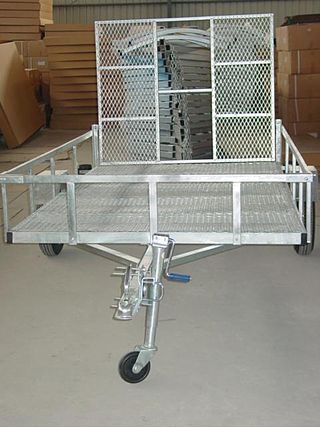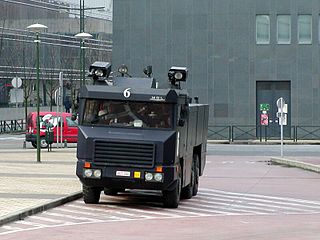
A semi-trailer truck, is the combination of a tractor unit and one or more semi-trailers to carry freight. A semi-trailer attaches to the tractor with a type of hitch called a fifth wheel.

A road train, also known as a land train or long combination vehicle (LCV) is a semi-truck used to move road freight more efficiently than single-trailer semi-trucks. It consists of one semi-trailer or more connected together with or without a tractor. It typically has to be at least three trailers and one tractor.

A tractor is an engineering vehicle specifically designed to deliver a high tractive effort at slow speeds, for the purposes of hauling a trailer or machinery such as that used in agriculture, mining or construction. Most commonly, the term is used to describe a farm vehicle that provides the power and traction to mechanize agricultural tasks, especially tillage, and now many more. Agricultural implements may be towed behind or mounted on the tractor, and the tractor may also provide a source of power if the implement is mechanised.

A trailer is an unpowered vehicle towed by a powered vehicle. It is commonly used for the transport of goods and materials.

A dump truck, known also as a dumping truck, dump trailer, dumper trailer, dump lorry or dumper lorry or a dumper for short, is used for transporting materials for construction as well as coal. A typical dump truck is equipped with an open-box bed, which is hinged at the rear and equipped with hydraulic rams to lift the front, allowing the material in the bed to be deposited ("dumped") on the ground behind the truck at the site of delivery. In the UK, Australia, South Africa and India the term applies to off-road construction plants only and the road vehicle is known as a tip lorry, tipper lorry, tipper truck, tip truck, tip trailer or tipper trailer or simply a tipper.
Scammell Lorries Limited was a British manufacturer of trucks, particularly specialist and military off-highway vehicles, between 1921 and 1988. From 1955 Scammell was part of Leyland Motors.

A tow hitch is a device attached to the chassis of a vehicle for towing, or a towbar to an aircraft nose gear. It can take the form of a tow ball to allow swiveling and articulation of a trailer, or a tow pin, or a tow hook with a trailer loop, often used for large or agricultural vehicles where slack in the pivot pin allows similar movements. Another category is the towing pintle used on military vehicles worldwide.

A tractor unit, also known as a truck unit, lorry unit, power unit, prime mover, ten-wheeler, semi-tractor, semi-truck, semi-lorry, tractor cab, truck cab, lorry cab, big rig tractor, big rig truck or big rig lorry or simply a tractor, truck, lorry, semi, big rig or rig, is a characteristically heavy-duty towing engine that provides motive power for hauling a towed or trailered load. These fall into two categories: heavy- and medium-duty military and commercial rear-wheel-drive semi-tractors used for hauling semi-trailers, and very heavy-duty typically off-road-capable, often 6×6, military and commercial tractor units, including ballast tractors.

A semi-trailer is a trailer without a front axle. The combination of a semi-trailer and a tractor truck is called a semi-trailer truck.

Towing is coupling two or more objects together so that they may be pulled by a designated power source or sources. The towing source may be a motorized land vehicle, vessel, animal, or human, and the load being anything that can be pulled. These may be joined by a chain, rope, bar, hitch, three-point, fifth wheel, coupling, drawbar, integrated platform, or other means of keeping the objects together while in motion.

An articulated hauler, articulated dump truck (ADT), or sometimes a dump hauler, is a very large heavy-duty type of dump truck used to transport loads over rough terrain, and occasionally on public roads. The vehicle usually has all-wheel drive and consists of two basic units: the front section, generally called the tractor, and the rear section that contains the dump body, called the hauler or trailer section. Steering is made by pivoting the front in relation to the back by hydraulic rams. This way, all wheels follow the same path, making it an excellent off-road vehicle.

A self-propelled modular transporter or sometimes self-propelled modular trailer (SPMT) is a platform heavy hauler with a large array of wheels which is an upgraded version of a hydraulic modular trailer. SPMTs are used for transporting massive objects, such as large bridge sections, oil refining equipment, cranes, motors, spacecraft and other objects that are too big or heavy for trucks. Ballast tractors can however provide traction and braking for the SPMTs on inclines and descents.

A drawbar is a solid coupling between a hauling vehicle and its hauled load. Drawbars are in common use with rail transport, road trailers, both large and small, industrial and recreational, and with agricultural equipment.

A tank transporter is a combination of a heavy tractor unit or a ballast tractor and a mating full trailer, hydraulic modular trailer or semi-trailer, used for transporting tanks and other armoured fighting vehicles. Some also function as tank recovery vehicles, the tractors of which may be armoured for protection in combat conditions.

Willème was a French truck manufacturer.

The concept of the Mechanical Horse tractor unit with an easily detached articulated trailer was conceived in the early 1930s by Napier & Son. It has one front wheel in the midline. The London and North Eastern Railway had approached Napier for an answer to the problem of replacing horses for local haulage purposes, while retaining the flexibility of changing the wagons and the maneuverability of the horse and wagon. These vehicles are often known as "Snub-nose Trucks" or "Snub-nose Lorries" because of the round hood in front of the cab.

MOL is a manufacturer of specialist trucks and trailers, based in Hooglede, Belgium. Specializes in manufacturing of trailers, waste vehicles, port equipement, trucks and rail equipments.

Nicolas Industrie S.A.S. is a French manufacturer of heavy trucks, trailers, HMT and SPMTs, mostly intended for oversize loads. Nicolas has been located in Champs-sur-Yonne since 1969, which is also when they started to develop vehicles meant particularly for very heavy loads. Their trucks, sold under the Tractomas brand, are built to single order. They most often incorporate Renault cabs and other parts, as well as a number of proprietary parts from manufacturers around the world. The Nicolas Tractomas TR1010 D100 currently holds the record as the world's largest road going truck, weighing in at 71 tonnes.

A hydraulic modular trailer (HMT) is a special platform trailer unit which feature swing axles, hydraulic suspension, independently steerable axles, two or more axle rows, compatible to join two or more units longitudinally and laterally and uses power pack unit (PPU) to steer and adjust height. These trailer units are used to transport oversized load, which are difficult to disassemble and are overweight. These trailers are manufactured using high tensile steel, which makes it possible to bear the weight of the load with the help of one or more ballast tractors which push and pull these units via drawbar or gooseneck this combination of tractor and trailer is also termed as heavy hauler.

Nicolas Tractomas is a heavy-duty built-to-order ballast tractor specifically to tow hydraulic modular trailers and road trains used for movement of oversize loads manufactured by French manufacturer Nicolas Industrie based in Auxerre. The tractor was bespoke build with preferred engine, gearbox, drivetrain and ballast with a Renault kerax cabin. The production of the tractor began in 1979 and lasted till 2016. The TR1010 D100 model of the tractor was awarded the Guinness World Record in 2015 for the largest road truck in the world, weighing 71 tons.
































